Over the weekend I visited two dying malls in San Francisco. I wanted to see what it looks like when retail gives way to emptiness — and what might come next.
From physical objects to virtual brands
Below you can see one corner of a gorgeous, cream-colored Art Deco building whose fate has become emblematic of San Francisco itself. Note the empty white sign on its left flank, a blank rectangle hovering above a big, square clock. It looks sort of like a giant exclamation point now, but for most of the teens, the sign read “@twitter.” After Elon Musk bought the company, he immediately began defacing the logo. First he ordered the “w” to be pained over so that the sign read “@titter.” Then he paid to have people build a huge glowing X on the roof. The sign was so bright and intrusive that the city forced Musk to remove it.
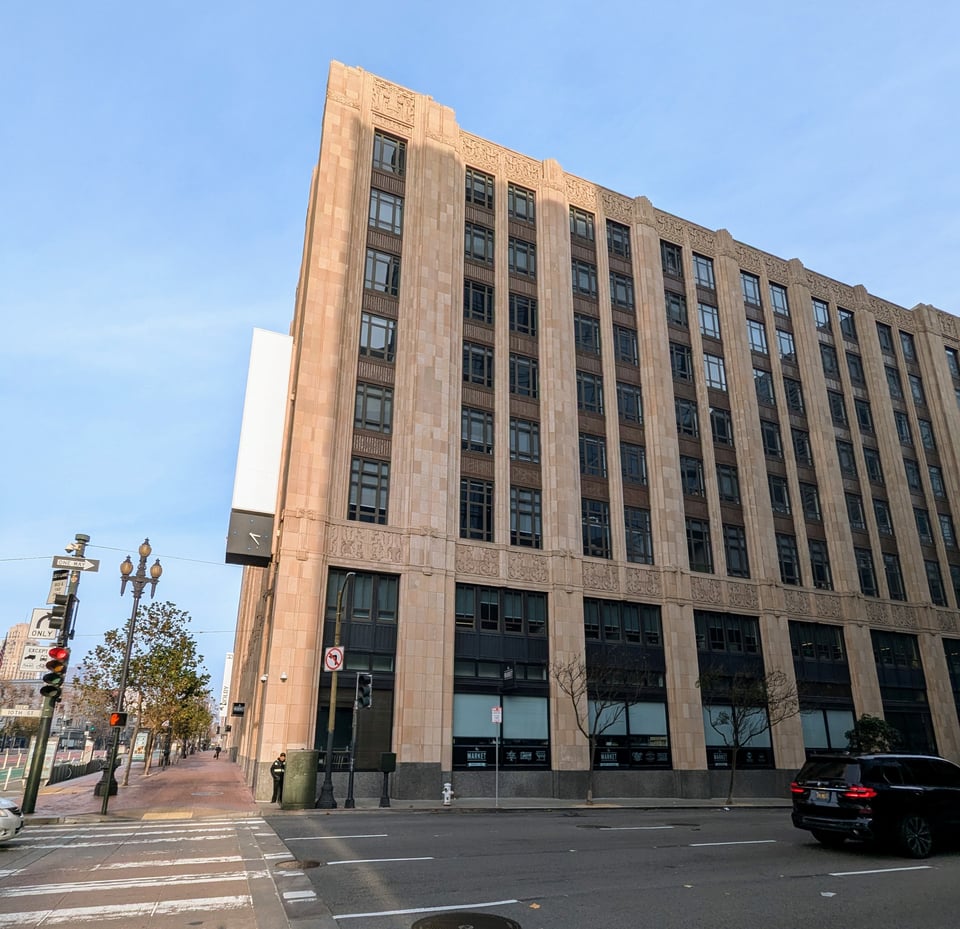
The saga of Twitter and X occupies a lot of ideological real estate in the media right now. And yet this shitposty, aggressive transformation of one brand into another was merely a blip in the long life of this former mall.
Decades before a social media oligarch occupied it, the building was an ever-growing sales warehouse and showroom for wholesale furniture and housewares companies. Opened in 1937 at the height of the Depression, the Western Furniture Exchange and Merchandise Mart’s many floors and wings boasted lavish displays of sofas, chandeliers, kitchen appliances, and more. The building’s elaborate Art Deco facade was infused with appropriated Mayan imagery. It was a showstopper.
During the post-World War II era, the Mart truly blossomed. Bolstered by 1950s and 60s middle class prosperity, its owners took over several adjacent buildings, filling them to the brim with tangible objects for physical spaces.

Home to over 300 wholesalers for 60 years, by 2008 it housed only 30. The Western Furniture Exchange and Merchandise Mart was sold in 2011 to the Shorenstein Company, a development firm that retrofitted it for a new economy devoted to social objects and virtual spaces.
Twitter moved in the following year. Tech worker offices replaced showrooms; the objects for sale were valuable but intangible and hard to quantify; a food court catering mostly to Twitter employees and a third wave coffee shop occupied the bottom floor. A grand shopping mall once open to the city’s public had become the purview of a few thousand corporate employees. And then, in just twelve years, the Mart was empty again.
Today, with signs removed, it exudes an overwhelming sense of peace and pleasant vacancy.
The death and life of the Emporium
A much more ambiguous fate has met San Francisco Centre, a mall that currently occupies a building known as The Emporium that dates back to 1896.
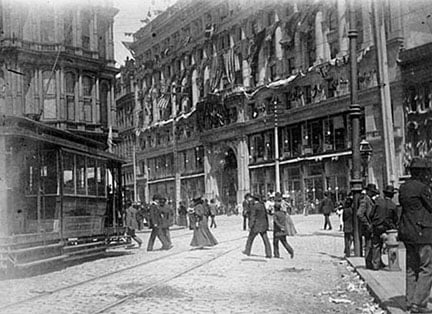
Constructed during the department store craze of the late 19th century, the Emporium was a massive building with a fussy neoclassical exterior.

Inside, it boasted two floors of shops and an elevated orchestra stand beneath a luxurious, domed ceiling. Its founder Adolph Feist ran it basically as a collective of of pop-ups, with individually owned shops selling everything from food to books. The Emporium’s seven upper floors were devoted to office spaces. (You can see a great photographic history of The Emporium via the Internet Archive’s record of an SF Gate story by Peter Hartlaub.)
Though the building was gutted in the quake and fire of 1906, the Emporium’s stone neoclassical facade somehow survived. Developers worked the old facade into a new building, with an even grander glass dome over a central atrium. Bands played there regularly, and The Emporium was a beloved hangout for decades. By the end of the twentieth century, however, it was flailing. After a corporate buyout in 1996, The Emporium closed. It was temporarily occupied by Macy’s, but mostly stood empty for the next ten years as various investors tried to put a deal together and renovate the building.
From 2002 to 2023, Westfield Group took over the space. Contractors completely rebuilt the Emporium from the inside out, preserving only its iconic neoclassical facade and the glass dome. The building was connected to the neighboring San Francisco Centre mall, anchored by a 4-floor Nordstrom’s wonderland. There was a fancy movie theater on its upper floor, tons of popular stores, and a thriving food court on its lowest level, packed with Instagram-famous vendors. You could enter the food court via a dedicated entrance from the Powell St. BART stop.

The hard times came again, more quickly than in the twentieth century. During the pandemic, many storefronts closed and never found new tenants. The food court started to bleed vendors. And then the death blow: in 2023, the movie theater closed, and Westfield pulled out just as the Nordstrom anchor store closed too.
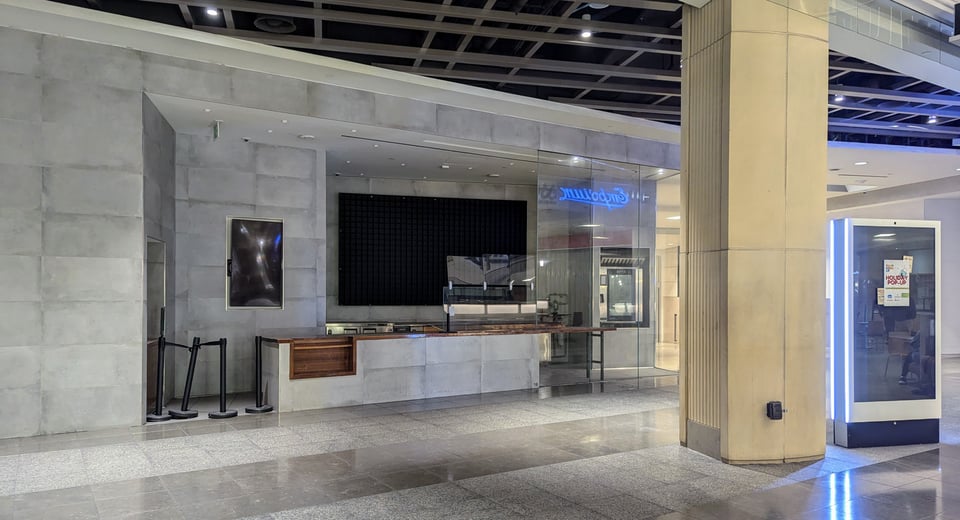
Pretty vacant
Now the combined Emporium building and SF Centre mall are largely empty, awaiting direction. Earlier this year, the Centre’s owners promised to maintain the space and continue seeking new tenants. There are still quite a few shops that remain open, but on a recent visit I didn’t see many shoppers.
There are so many poignant ways the mall tries to hide the missing teeth on its shining promenades. Workers cover abandoned window displays with cheerful signage, as if the mall is supposed to have giant design displays instead of stores.

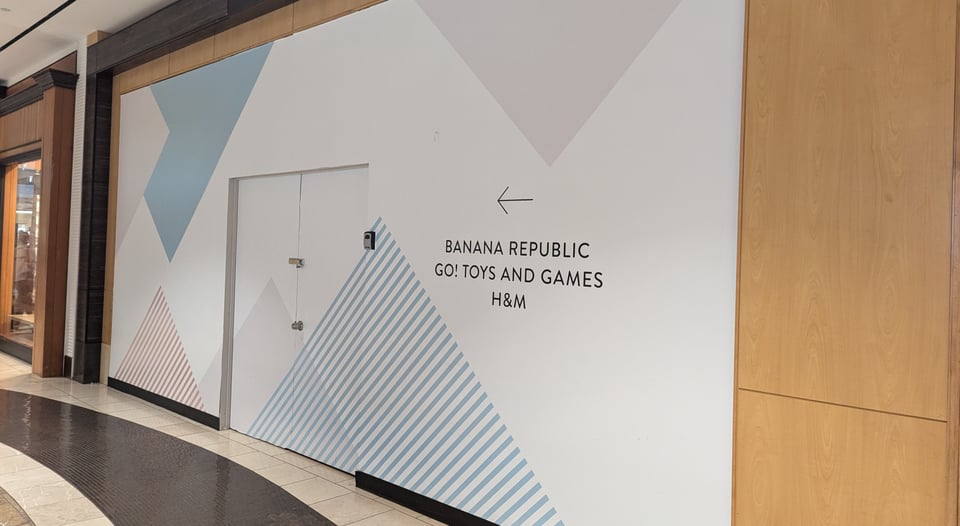

Above on the left you can see more design camouflage on an empty storefront. A yellow-and-white cartoon rabbit skull and crossbones radiate rainbow colors. The text next to the psychedelic bunny promises that you can “discover a vibrant world around the corner.” On the right, you can see that vibrant world — a papered-over glass door edged in gilt, its signage stripped away to reveal light sockets.
Below, a glass countertop is filled with bleak signs that say “warning security armed.” It’s unclear what exactly is being secured, since its tenants and their wares are long gone.
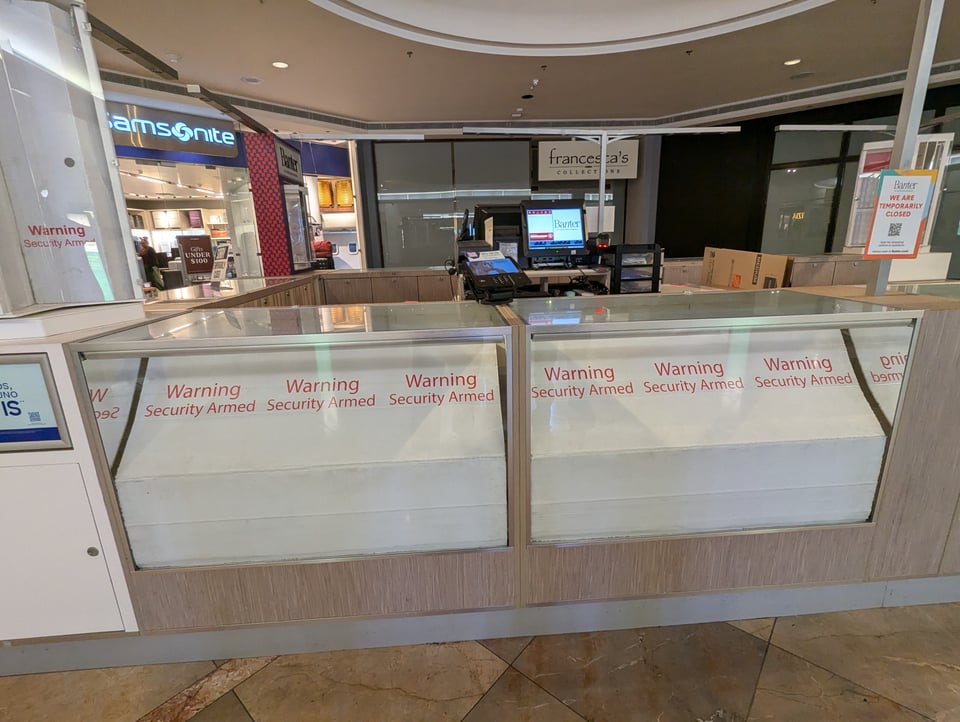
Last Saturday when I visited, at least one part of the Emporium was alive. That spot under the dome, beloved since 1908, was bustling.
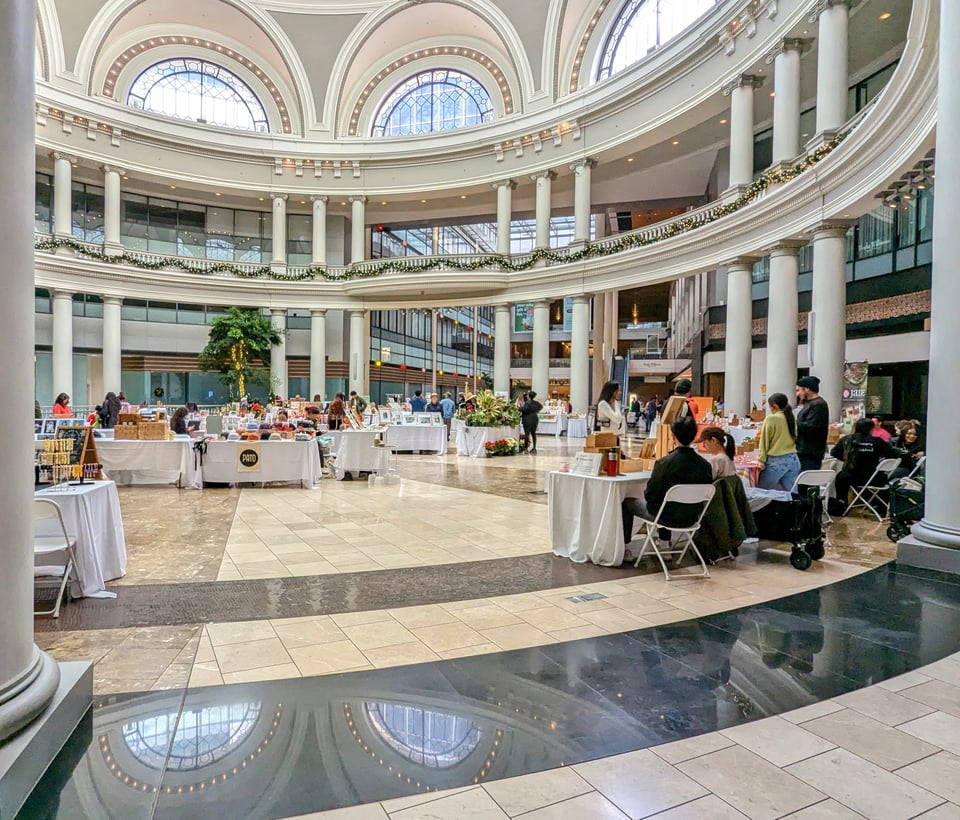
The city’s Office of Economic and Workforce Development (OEWD) had partnered with local arts organizations to put on a holiday market. A band was playing, and shoppers were milling around happily, looking at the art, food, and housewares on offer. At one table, I even got to meet Afatasi The Artist, whose wild, futuristic murals about Black life in San Francisco I had admired on road dividers along Evans Avenue. Plus, I bought some delicious black sesame shortbread and brittle from Mojo Bakes.
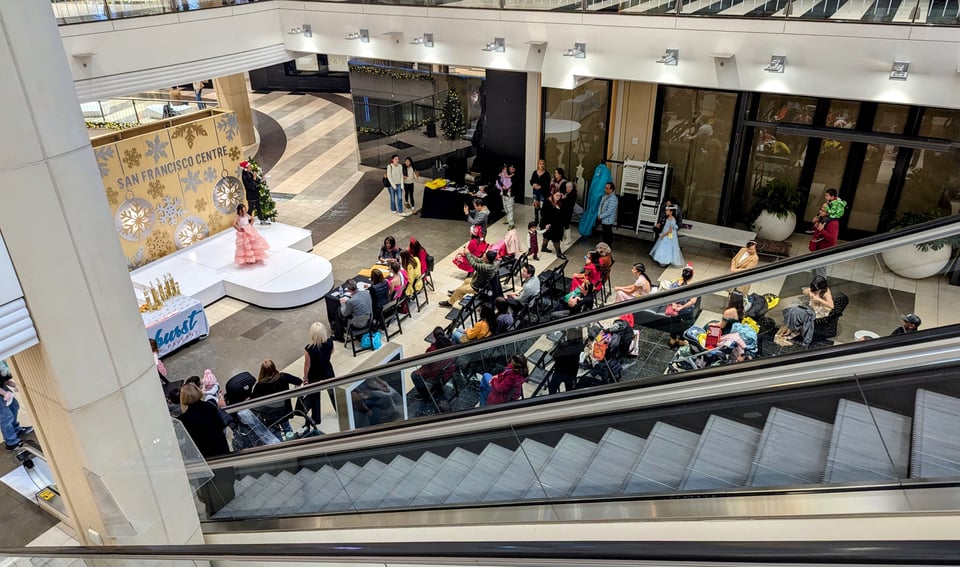
I stood next to the escalator with my cookies and a flyer for Afatasi’s latest show. On the level below us was another gathering in the empty mall. At first I thought it was a magic show, but quickly realized it was a beauty pageant for little girls. That was horrifying for reasons too numerous to go into here, but it was still a good example of how community events are taking over a building once devoted to retail.
Liminal
As I ascended toward the blank spaces where Nordstrom once ruled, I found a glorious unbranded emptiness that future archaeologists will no doubt describe as “ceremonial chambers” or “special use spaces.”

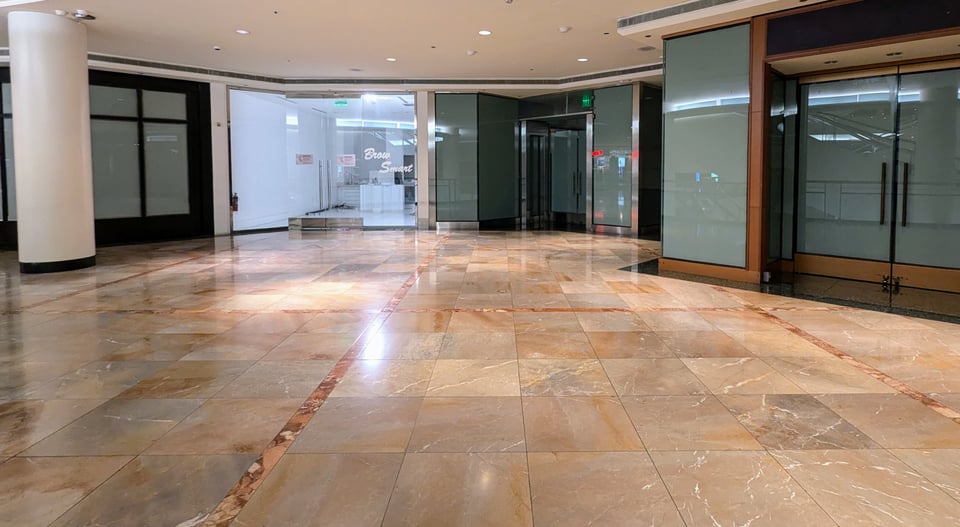
The mall seemed to degenerate into absurdism as I continued to ride the escalators up. Twinkling strands of gilded holiday decorations fell from the distant, illuminated ceiling, past five dark levels of unfilled retail space.

I remembered visiting SF Centre roughly twenty-five years ago, when I needed an outfit for my first grown-up job interviews. I rode the escalator up and up, gazing at floors thick with crowds, hoping to find the perfect suit at Nordstrom. The air had that vaguely nauseating mall smell, like cookies and perfume and new leather.
Now it is just abstract space divided up into further abstraction, light and shadow sandwiched meaninglessly together behind infinite golden railings.

The dizzying architectural landscape of the mall, designed to confuse shoppers and keep them circulating through infinite consumerism, has lost its power. But there is nothing to replace it.
In the absence of any organizing force, perhaps the place will revert to what it was in the 1890s: a lovely spot for pop-up shops, at a time when America’s future was extremely tenuous. The city’s many communities might gather here again, under the dome, to buy things. Or to distract themselves from economic uncertainty and escalating international conflict.
I wound my way through the Emporium’s beautiful, useless innards, looking for the exit and hoping for something better.
Books for the holidays!
I have so many books for you! You can order signed copies of any of my books at Green Apple Books, or order from your local indie bookstore via Bookshop.org.
My latest book, Stories Are Weapons, is particularly relevant at the moment. It’s about the history of psyops and culture war in the United States — and how people have always fought back (and won!) against disinformation and propaganda.
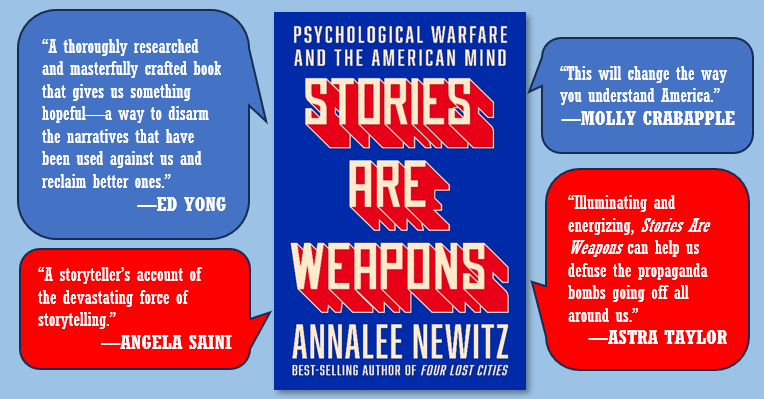
One of my most popular books is Four Lost Cities, an archaeological exploration of four of the world’s greatest cities — and why people abandoned them. I have been told repeatedly that dads and dad-esque people love this book.

And of course, you should spend the holidays hanging out with flying moose and sentient public transit. The only way to do that is to read my novel The Terraformers.

Also, please consider pre-ordering my next book, Automatic Noodle! You can pre-order through Green Apple (link above), your local indie bookstore, or Bookshop.org. Automatic Noodle is about rebuilding San Francisco after a devastating war. It stars a group of robots who take over a ghost kitchen to dish up some of tastiest hand-pulled noodles in the city!

You just read issue #34 of The Hypothesis. You can also browse the full archives of this newsletter.